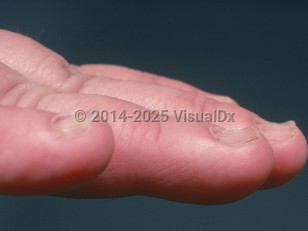Koilonychia - Nail and Distal Digit
Alerts and Notices
Important News & Links
Synopsis

This summary discusses koilonychia in adults and children. Koilonychia in infants is discussed separately.
Koilonychia describes a concave nail condition with a central depression and everted edges, often nicknamed "spoon-nail." Koilonychia can be categorized as acquired, idiopathic, or hereditary. Most cases are acquired.
Acquired koilonychias may be caused by dermatologic diseases such as psoriasis and lichen planus, or by systemic diseases such as iron-deficiency anemia or Plummer-Vinson syndrome. Koilonychia occurs in 5.4% of patients with iron-deficiency anemia, and nail ridging and brittleness are also observed. Plummer-Vinson syndrome is rare and is characterized by the triad of dysphagia, esophageal webs, and iron-deficiency anemia; squamous cell carcinoma will develop in the upper aerodigestive tract in 3%-15% of these patients.
Idiopathic koilonychia is the second most common form and may be assumed after a thorough workup including history, physical examination, and laboratory testing. It can present as serrated koilonychia, a combination of koilonychia and deep longitudinal grooves.
Hereditary koilonychias are the least common form. Hemochromatosis is an autosomal recessive disorder of iron accumulation, and koilonychia is seen in 49% of these patients.
Familial koilonychia is rare and inherited in an autosomal dominant manner. Nails are thin and flat and then develop concavity over time.
Transient acquired koilonychia is seen in at least 5% of normal 2-year-olds. It normally affects the toes and is more common when children walk barefoot. Other causes are trauma, tightly fitting shoes, and finger sucking. It usually resolves by age 9. Anemia and nutritional deficiencies should be ruled out first in these cases.
The pathogenesis of koilonychia is not well understood. According to one hypothesis, it results from a reduction of blood flow to the subungual connective tissue, resulting in a relative depression of the distal nail matrix compared with the proximal matrix.
Koilonychia describes a concave nail condition with a central depression and everted edges, often nicknamed "spoon-nail." Koilonychia can be categorized as acquired, idiopathic, or hereditary. Most cases are acquired.
Acquired koilonychias may be caused by dermatologic diseases such as psoriasis and lichen planus, or by systemic diseases such as iron-deficiency anemia or Plummer-Vinson syndrome. Koilonychia occurs in 5.4% of patients with iron-deficiency anemia, and nail ridging and brittleness are also observed. Plummer-Vinson syndrome is rare and is characterized by the triad of dysphagia, esophageal webs, and iron-deficiency anemia; squamous cell carcinoma will develop in the upper aerodigestive tract in 3%-15% of these patients.
Idiopathic koilonychia is the second most common form and may be assumed after a thorough workup including history, physical examination, and laboratory testing. It can present as serrated koilonychia, a combination of koilonychia and deep longitudinal grooves.
Hereditary koilonychias are the least common form. Hemochromatosis is an autosomal recessive disorder of iron accumulation, and koilonychia is seen in 49% of these patients.
Familial koilonychia is rare and inherited in an autosomal dominant manner. Nails are thin and flat and then develop concavity over time.
Transient acquired koilonychia is seen in at least 5% of normal 2-year-olds. It normally affects the toes and is more common when children walk barefoot. Other causes are trauma, tightly fitting shoes, and finger sucking. It usually resolves by age 9. Anemia and nutritional deficiencies should be ruled out first in these cases.
The pathogenesis of koilonychia is not well understood. According to one hypothesis, it results from a reduction of blood flow to the subungual connective tissue, resulting in a relative depression of the distal nail matrix compared with the proximal matrix.
Codes
ICD10CM:
L60.3 – Nail dystrophy
SNOMEDCT:
66270006 – Koilonychia
L60.3 – Nail dystrophy
SNOMEDCT:
66270006 – Koilonychia
Look For
Subscription Required
Diagnostic Pearls
Subscription Required
Differential Diagnosis & Pitfalls

To perform a comparison, select diagnoses from the classic differential
Subscription Required
Best Tests
Subscription Required
Management Pearls
Subscription Required
Therapy
Subscription Required
References
Subscription Required
Last Reviewed:03/20/2017
Last Updated:04/02/2017
Last Updated:04/02/2017
Koilonychia - Nail and Distal Digit

